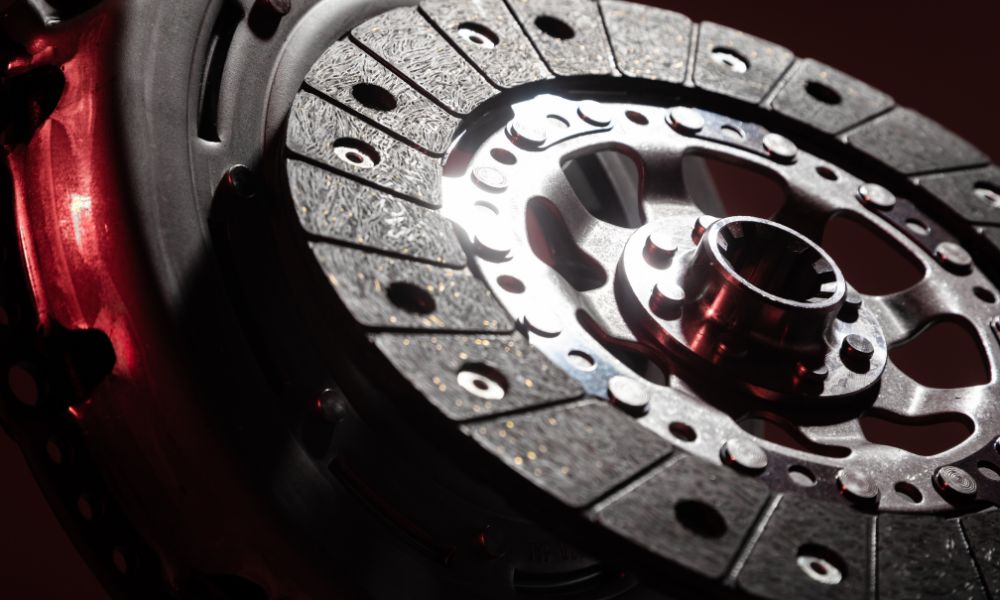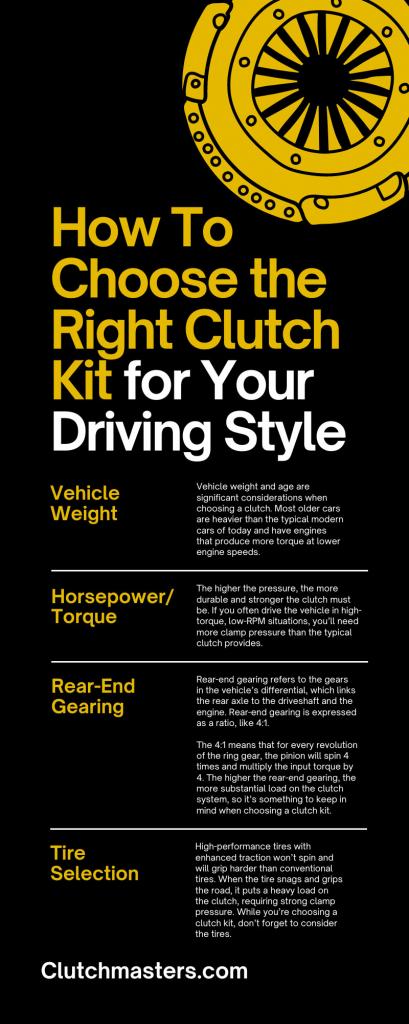How To Choose the Right Clutch Kit for Your Driving Style

The clutch is integral to the performance and drivability of your vehicle. Drivers must get a clutch kit that fits their vehicle, the car’s intended use, and the owner’s driving style. Below, we’ll show you how to choose the right clutch kit for your driving style by outlining what owners need to consider, the stages of clutch kits, and clutch disc materials.
Considerations When Choosing a Clutch Kit
There are many factors that a vehicle owner must consider before installing a new clutch kit on their vehicle. The most important factors every driver should consider are their vehicle’s weight, performance output, rear-end gearing, and more.
Vehicle Weight
Vehicle weight and age are significant considerations when choosing a clutch. Most older cars are heavier than the typical modern cars of today and have engines that produce more torque at lower engine speeds.
This combination of vehicle weight and torque can apply a lot of pressure on the clutch, which can cause slipping or overheating if applied to a clutch that’s not built to withstand such pressure. If you’ve got an older, heavier vehicle, you’ll want to consider a clutch kit with more clamp pressure and durability than most performance clutches.
Horsepower/Torque
The performance output of the vehicle is a significant factor when selecting a clutch kit for a performance vehicle; the higher the operating RPM range of the engine, the more centrifugal pressure is applied by the pressure plate.
The higher the pressure, the more durable and stronger the clutch must be. If you often drive the vehicle in high-torque, low-RPM situations, you’ll need more clamp pressure than the typical clutch provides.
Rear-End Gearing
Rear-end gearing refers to the gears in the vehicle’s differential, which links the rear axle to the driveshaft and the engine. Rear-end gearing is expressed as a ratio, like 4:1.
The 4:1 means that for every revolution of the ring gear, the pinion will spin 4 times and multiply the input torque by 4. The higher the rear-end gearing, the more substantial load on the clutch system, so it’s something to keep in mind when choosing a clutch kit.
Tire Selection
Even the tires play a role when selecting a clutch kit for your vehicle. Mostly, tire selection comes down to the vehicle’s intended use and whether the car has performance, drag racing, or more conventional street tires.
High-performance tires with enhanced traction won’t spin and will grip harder than conventional tires. When the tire snags and grips the road, it puts a heavy load on the clutch, requiring strong clamp pressure. While you’re choosing a clutch kit, don’t forget to consider the tires.
Driving Style
Finally, we have the most important consideration for how to choose the right clutch kit, your driving style, and the vehicle’s use. Clutch kits that are better used for the workday commute and prioritize longevity won’t have the necessary pressure that high-performance vehicles need to push to the limit.
For drag racing cars, for example, quick engagement and high torque are essential, while for street cars, there’s a more even balance between performance and drivability. If the car is mostly used for competition, you’ll want a higher-stage clutch kit with more clamping pressure; if the car will mostly be driving on the streets, a lower-stage clutch is better for driver comfort and durability.
Different Stages of Performance Clutches
We mentioned stages with performance clutch kits, but what do they mean? The clutch stage is the maximum or recommended horsepower range for the kit. A clutch’s stage is influenced by factors like the clutch disc materials, pressure plate clamping force, and power handling.
The stages of our single disc clutch kits are arranged from one to five, with stage five being the strongest that can handle the highest friction while stage one is the softest. Drivers should also compare clutch stages of only the same manufacturer, as a stage three clutch from one clutch kit manufacturer may be different than a stage three clutch from another.
Clutch Materials
One of the factors that will determine the clutch’s stage rating is the composition of the clutch disc materials. Not all clutches are made equally, and there are many different types of clutch materials, but the main three categories to consider are organic, Kevlar, or metallic clutch materials. We’ll explain each offer and how it affects the clutch and vehicle below.
Organic
Organic is considered the softest clutch material and is generally reserved for lower-stage clutches for street-level cars and performance. Organic clutches are composed of a variety of materials and elements, such as:
- Fiberglass
- Carbon fiber
- Brass wire
- Cotton string
- And more
Organic disc clutches provide solid grip but are not considered the most high-performance and competition-worthy options. An organic clutch on a high-performance car will overheat, but they are less prone to chatter than other, tougher clutch disc materials, making them much more viable for daily driven street vehicles, delivering stock or slightly more then stock horsepower.
Kevlar
One of the most common clutch disc materials is Kevlar. These clutch discs are made of the same material as bulletproof vests—a woven aramid material that is heated, then pressed to form the lining.
Kevlar clutches are a step up in durability and performance but are more prone to chatter than organic. In many cases, Kevlar clutches provide the ideal compromise between high performance and drivability. If the car you’re installing a clutch kit will split time between the track and the streets, a Kevlar clutch is likely the best option.
Metallic
Finally, there’s the hardest clutch material available: metallic. Metallic or sintered clutches are composed mostly of bronze or iron and are for the most serious racers. Metallic clutches are composed of sintered materials, which means they’re bonded together by heat without melting, so it’s less likely to overheat under extreme circumstances.
A metallic clutch is likely the best choice if it’s a high-performance competition vehicle that will rarely be driven on the streets. Metallic clutches are great for competition cars but produce the most clutch chatter, so they’re not ideal for street driving. Our primary metallic material option is ceramic. This isn’t the type of ceramic you might imagine pottery being made from but is actually a mixture of different metallic and organic materials such as copper, iron, silicon dioxide, tin bronze, and occasionally graphite.
Where Can I Get a Performance Clutch Kit for My Car?
If you need a clutch kit for your high-performance vehicle, Clutch Masters Industries can help! We offer a wide selection of hydraulic clutch parts and everything a driver needs to maximize performance and acceleration in their vehicle. Browse our inventory or contact our staff if you need help selecting the ideal clutch kit for your car today!



